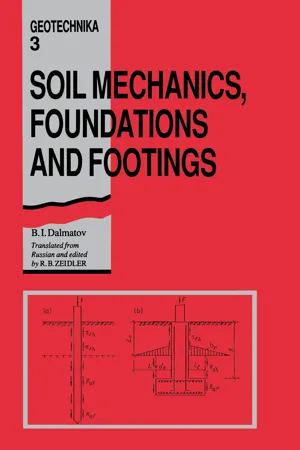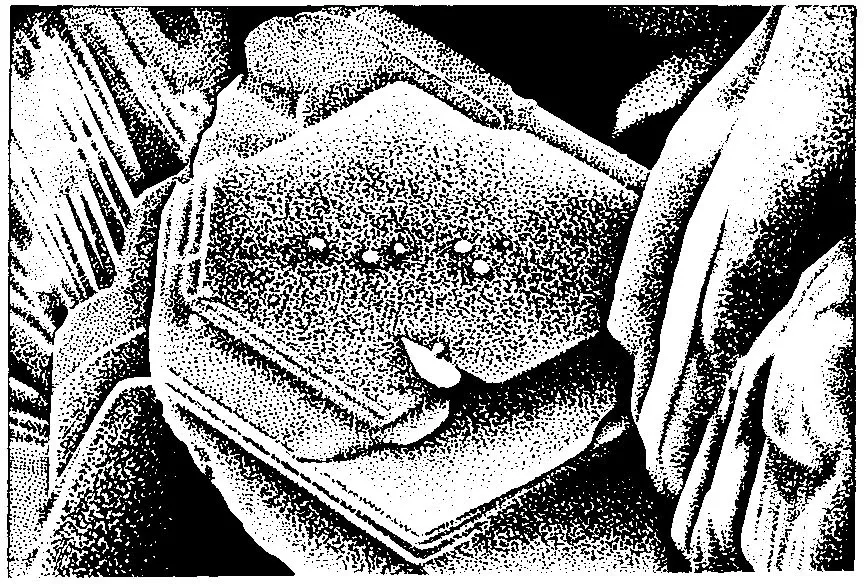
eBook - ePub
Soil Mechanics, Footings and Foundations
Geotechnika - Selected Translations of Russian Geotechnical Literature 3
- 414 pages
- English
- ePUB (mobile friendly)
- Available on iOS & Android
eBook - ePub
Soil Mechanics, Footings and Foundations
Geotechnika - Selected Translations of Russian Geotechnical Literature 3
About this book
Translated from the second Russian edition of 1988. Parts 2, "Soil mechanics" and 3, "Foundations and footings" are revised and updated versions of the first Russian edition of 1981. Part 1, "Special course in engineering geology, " contains a discussion of physicomechanical properties of soil, geody
Frequently asked questions
Yes, you can cancel anytime from the Subscription tab in your account settings on the Perlego website. Your subscription will stay active until the end of your current billing period. Learn how to cancel your subscription.
At the moment all of our mobile-responsive ePub books are available to download via the app. Most of our PDFs are also available to download and we're working on making the final remaining ones downloadable now. Learn more here.
Perlego offers two plans: Essential and Complete
- Essential is ideal for learners and professionals who enjoy exploring a wide range of subjects. Access the Essential Library with 800,000+ trusted titles and best-sellers across business, personal growth, and the humanities. Includes unlimited reading time and Standard Read Aloud voice.
- Complete: Perfect for advanced learners and researchers needing full, unrestricted access. Unlock 1.4M+ books across hundreds of subjects, including academic and specialized titles. The Complete Plan also includes advanced features like Premium Read Aloud and Research Assistant.
We are an online textbook subscription service, where you can get access to an entire online library for less than the price of a single book per month. With over 1 million books across 1000+ topics, we’ve got you covered! Learn more here.
Look out for the read-aloud symbol on your next book to see if you can listen to it. The read-aloud tool reads text aloud for you, highlighting the text as it is being read. You can pause it, speed it up and slow it down. Learn more here.
Yes! You can use the Perlego app on both iOS or Android devices to read anytime, anywhere — even offline. Perfect for commutes or when you’re on the go.
Please note we cannot support devices running on iOS 13 and Android 7 or earlier. Learn more about using the app.
Please note we cannot support devices running on iOS 13 and Android 7 or earlier. Learn more about using the app.
Yes, you can access Soil Mechanics, Footings and Foundations by B.I. Dalmatov in PDF and/or ePUB format, as well as other popular books in Technology & Engineering & Agronomy. We have over one million books available in our catalogue for you to explore.
Information
PART ONE
SPECIAL COURSE OF ENGINEERING GEOLOGY
SPECIAL COURSE OF ENGINEERING GEOLOGY
CHAPTER 1
Physical properties of soil
1.1 SOIL ORIGIN AND COMPONENTS, AND PROPERTIES OF SOIL CONSTITUENTS
1.1.1 Origin of soil
Magmatic rock was generated upon cooling of magma and as a result of orogenic processes. Physical and chemical weathering factors have gradually transformed this rock into loose rock fragments. The disintegrated fragments of rock were removed into lower areas of the earth surface, where they were ground, deposited and settled as sedimentary rock. In some cases, at high pressures and temperatures, sedimentary rocks were subject to metamorphism, so that metamorphic rock was generated. If the metamorphic rock was close to the earth surface as the result of orogenic processes, then the chemical weathering brought about generation of coarse skeletal or fine disperse soil. In general, soil is referred to by civil engineers as the upper layer of the Earth’s crust subject to weathering; it embodies rock, semi-rock and loose rock materials.
In most cases the upper layers of the Earth’s crust consist of coarse-grained, sandy, silty-clayey, organic and technogenic soils. The disperse soils occur almost everywhere below the surface of the Earth. Therefore we are calling them soil henceforth, and will distinquish them from rock and semi-rock soils.
The major part of disperse soil was generated as a result of the accumulation of the products of physical and chemical weathering. Some soils have been generated as an outcome of deposition of organic matter (peat, etc), or as a result of artificial or hydraulic filling of different materials (technogenic deposits). Coarse-grained and sandy soils were generated in the course of physical weathering. Minerals in the fine, disperse part of silty-clayey soils have been generated by processes of chemical and partly biological weathering.
Depending on the conditions of generation, soils can be categorized as terrigenic or marine. The former include alluvia, proalluvia, delluvium, talus, deltaic, lagoon, aeolian and all types of glacial deposits, while the latter encompass all sea-borne materials transported to the sea by surface run-off.
Due to the differences in the conditions of generation and diagenesis, the properties of soils are very diversified. In a number of cases, one soil of the same origin can display different properties. Hence soils can be inhomogeneous and non-uniform in vertical and horizontal directions.
1.1.2 Soil constituents
In most cases soils consist of the following three components: solid particles (solid phase), water (liquid phase) and air or another gas (gaseous phase). The relationships of these components determine many properties of soils.
If soil consists of solid particles, all voids between which are filled up with water, it is referred to as two-component (two-phase) system. Sometimes such soil is called a soil mass. However, in most cases soil contains not only solid particles and water but also air or another gas, either dissolved in the pore water or in the form of bubbles surrounded by the pore water, which can even communicate freely with the atmosphere. Such soil is referred to as a three-component (three-phase) system.
Ice (a plastic body) is contained additionally in a frozen soil. It provides specific properties which must be taken into consideration, particularly in the construction in permafrost regions. Frozen soil is a four-phase system.
In some soils, organic matter occurs as vegetative residuum or humus. The presence of even minute quantities of such matter in soil (above 3% in sand and 5% in silty-clayey soil) controls appreciably the properties of soil.
1.1.3 Short classification of solid particles in soil
Since properties of soil are strongly controlled by the size and the mineralogical composition of its solid particles, the following classification by grain size has been accepted:
| Kind of solid particles | Size in mm |
| Pebbles (rubble) | > 20 mm |
| Gravel (druss) | 20–2 mm |
| Sand | 2–0.05 mm |
| Silt | 0.05–0.005 mm |
| Clay | < 0.005 mm |
The names given in the parantheses are accepted for sharp-edged grains.
The contents of clay minerals is also accounted for to a certain degree because in most cases the size of clay particles is below 0.005 mm. Particles above 0.05 mm are usually sharp-edged or round, while finer clay particles assume the shape of plates (Fig. 1.1) or sometimes needles. In turn, sand grains are categorized as coarse, medium and fine while silt particles can be either coarse or fine.
Coarse soil grains are screened on a sieve. The percentage of grains finer than 0.1 mm is determined by the fall velocity of idealized spherical particles in water. In this case the dimension of the particles shown above should be regarded as their hydraulic diameter (in the scale derived by Sabakin). If the Stokes scale is used it is assumed that clay particles have the hydraulic diameter below 0.002 mm.

The division of soil particles in categories is substantiated by the fact that the soils consisting of one category of particles have their own specific properties.
A soil consisting solely of pebbles (rubble) is highly permeable, possesses a rigid skeleton and a high bearing capacity. A soil consisting exclusively of gravel particles is also very permeable and has a fairly rigid skeleton and sufficiently high bearing capacity. It can be compacted in some cases under dynamic effects. The two types of soil do not possess the property of cohesion (they are loose), and the capillary rise does not occur in them.
Sand grains generate different sand categories possessing the properties of permeability; they are not plastic, have fairly rigid skeleton and are little compressible under static loading. The following classes of sand are distinguished by its granulometric composition:
| Category of sand | Description |
| Gravelly | Grains above 2 mm in the quantity above 25% by mass |
| Coarse | Grains above 0.5 mm exceeding 50% |
| Medium | Grains above 0.25 mm exceeding 50% |
| Fine | Grains coarser than 0.1 mm exceeding 75% |
| Silty | Grains coarser than 0.1 mm below 75% |
Depending on the structure of sand grains they can be subject to considerable compaction under dynamic effects. The capillary rise in sand is insignificant (up to 0.5 m), and sand is a loose body in dry condition.
A soil consisting exclusively of clay particles is practically impermeable, is characterized by high plasticity in wet condition, can possess considerable compressibility under static loading, does not consolidate under dynamic loading, but can reduce...
Table of contents
- Cover
- Half Title
- Soil Mechanics, Footings and Foundations
- Title Page
- Copyright Page
- Table of Contents
- INTRODUCTION
- PART ONE: SPECIAL COURSE OF ENGINEERING GEOLOGY
- PART TWO: SOIL MECHANICS
- PART THREE: FOUNDATIONS AND FOOTINGS
- CLOSURE
- NOTATION
- APPENDICES: STANDARD STRENGTH AND DEFORMATION PROPERTIES OF SOIL (BY THE SOVIET STANDARDS SNiP 2.02.01-83)
- REFERENCES